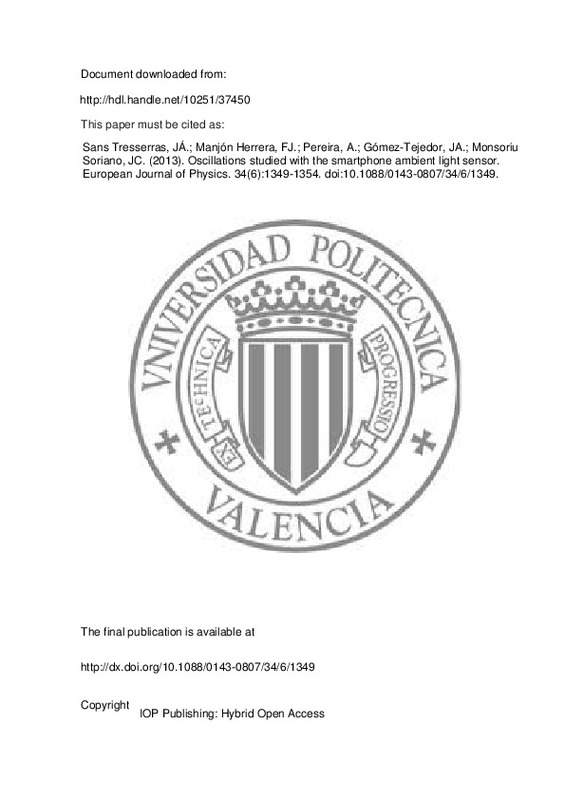JavaScript is disabled for your browser. Some features of this site may not work without it.
Buscar en RiuNet
Listar
Mi cuenta
Estadísticas
Ayuda RiuNet
Admin. UPV
Oscillations studied with the smartphone ambient light sensor
Mostrar el registro sencillo del ítem
Ficheros en el ítem
| dc.contributor.author | Sans Tresserras, Juan Ángel
|
|
| dc.contributor.author | Manjón Herrera, Francisco Javier
|
es_ES |
| dc.contributor.author | Pereira, A.L.J.
|
es_ES |
| dc.contributor.author | Gómez-Tejedor, José Antonio
|
es_ES |
| dc.contributor.author | Monsoriu Soriano, Juan Carlos
|
es_ES |
| dc.date.accessioned | 2014-05-13T12:25:32Z | |
| dc.date.issued | 2013-11 | |
| dc.identifier.issn | 0143-0807 | |
| dc.identifier.uri | http://hdl.handle.net/10251/37450 | |
| dc.description.abstract | This paper makes use of a smartphone's ambient light sensor to analyse a system of two coupled springs undergoing either simple or damped oscillatory motion. The period, frequency and stiffness of the spring, together with the damping constant and extinction time, are extracted from light intensity curves obtained using a free Android application. The results demonstrate the instructional value of mobile phone sensors as a tool in the physics laboratory. | es_ES |
| dc.description.sponsorship | The authors would like to thank the Institute of Education Sciences, Universitat Politecnica de Valencia (Spain) for the support of the Teaching Innovation Groups, e-MACAFI and MoMa. | en_EN |
| dc.language | Inglés | es_ES |
| dc.publisher | IOP Publishing: Hybrid Open Access | es_ES |
| dc.relation.ispartof | European Journal of Physics | es_ES |
| dc.rights | Reserva de todos los derechos | es_ES |
| dc.subject | Physics experiments | es_ES |
| dc.subject.classification | FISICA APLICADA | es_ES |
| dc.title | Oscillations studied with the smartphone ambient light sensor | es_ES |
| dc.type | Artículo | es_ES |
| dc.identifier.doi | 10.1088/0143-0807/34/6/1349 | |
| dc.rights.accessRights | Abierto | es_ES |
| dc.contributor.affiliation | Universitat Politècnica de València. Instituto de Diseño para la Fabricación y Producción Automatizada - Institut de Disseny per a la Fabricació i Producció Automatitzada | es_ES |
| dc.contributor.affiliation | Universitat Politècnica de València. Departamento de Física Aplicada - Departament de Física Aplicada | es_ES |
| dc.description.bibliographicCitation | Sans Tresserras, JÁ.; Manjón Herrera, FJ.; Pereira, A.; Gómez-Tejedor, JA.; Monsoriu Soriano, JC. (2013). Oscillations studied with the smartphone ambient light sensor. European Journal of Physics. 34(6):1349-1354. doi:10.1088/0143-0807/34/6/1349 | es_ES |
| dc.description.accrualMethod | S | es_ES |
| dc.relation.publisherversion | http://dx.doi.org/10.1088/0143-0807/34/6/1349 | es_ES |
| dc.description.upvformatpinicio | 1349 | es_ES |
| dc.description.upvformatpfin | 1354 | es_ES |
| dc.type.version | info:eu-repo/semantics/publishedVersion | es_ES |
| dc.description.volume | 34 | es_ES |
| dc.description.issue | 6 | es_ES |
| dc.relation.senia | 246997 | |
| dc.contributor.funder | Instituto de Ciencias de la Educación, Universitat Politècnica de València | es_ES |
| dc.description.references | Monsoriu, J. A., Giménez, M. H., Riera, J., & Vidaurre, A. (2005). Measuring coupled oscillations using an automated video analysis technique based on image recognition. European Journal of Physics, 26(6), 1149-1155. doi:10.1088/0143-0807/26/6/023 | es_ES |
| dc.description.references | Shamim, S., Zia, W., & Anwar, M. S. (2010). Investigating viscous damping using a webcam. American Journal of Physics, 78(4), 433-436. doi:10.1119/1.3298370 | es_ES |
| dc.description.references | Ochoa, O. R., & Kolp, N. F. (1997). The computer mouse as a data acquisition interface: Application to harmonic oscillators. American Journal of Physics, 65(11), 1115-1118. doi:10.1119/1.18732 | es_ES |
| dc.description.references | Ng, T. W., & Ang, K. T. (2005). The optical mouse for harmonic oscillator experimentation. American Journal of Physics, 73(8), 793-795. doi:10.1119/1.1862634 | es_ES |
| dc.description.references | Tomarken, S. L., Simons, D. R., Helms, R. W., Johns, W. E., Schriver, K. E., & Webster, M. S. (2012). Motion tracking in undergraduate physics laboratories with the Wii remote. American Journal of Physics, 80(4), 351-354. doi:10.1119/1.3681904 | es_ES |
| dc.description.references | Ballester, J., & Pheatt, C. (2013). Using the Xbox Kinect sensor for positional data acquisition. American Journal of Physics, 81(1), 71-77. doi:10.1119/1.4748853 | es_ES |
| dc.description.references | Vannoni, M., & Straulino, S. (2007). Low-cost accelerometers for physics experiments. European Journal of Physics, 28(5), 781-787. doi:10.1088/0143-0807/28/5/001 | es_ES |
| dc.description.references | Skeffington, A., & Scully, K. (2012). Simultaneous Tracking of Multiple Points Using a Wiimote. The Physics Teacher, 50(8), 482-484. doi:10.1119/1.4758151 | es_ES |
| dc.description.references | Castro-Palacio, J. C., Velázquez-Abad, L., Giménez, F., & Monsoriu, J. A. (2013). A quantitative analysis of coupled oscillations using mobile accelerometer sensors. European Journal of Physics, 34(3), 737-744. doi:10.1088/0143-0807/34/3/737 | es_ES |
| dc.description.references | Carlos Castro-Palacio, J., Velázquez-Abad, L., Giménez, M. H., & Monsoriu, J. A. (2013). Using a mobile phone acceleration sensor in physics experiments on free and damped harmonic oscillations. American Journal of Physics, 81(6), 472-475. doi:10.1119/1.4793438 | es_ES |
| dc.description.references | Ouseph, P. J., Driver, K., & Conklin, J. (2001). Polarization of light by reflection and the Brewster angle. American Journal of Physics, 69(11), 1166-1168. doi:10.1119/1.1397457 | es_ES |
| dc.description.references | Berger, J. (1988). On potential energy, its force field and their measurement along an air track. European Journal of Physics, 9(1), 47-50. doi:10.1088/0143-0807/9/1/008 | es_ES |







![[Cerrado]](/themes/UPV/images/candado.png)

